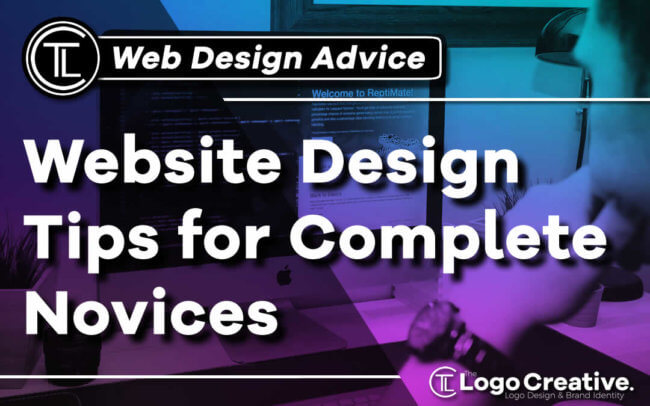For the past 30 years, everybody – from complete novices to professional web developers – have used a variety of tools to create and maintain web presences. Over this time, the notion of web design has evolved considerably. In this article we share some Website Design Tips for Complete Novices.
We’re long removed from the days of pages that could utilise the “under construction” disclaimers and have since arrived in a world where instant digital gratification is expected.
Every day, first-time website designers find themselves facing all of the challenges that their proverbial digital ancestors once faced.
From building a basic navigational menu to deciding on aesthetics, there is a lot to consider when building a website for the first time.
What tips can help make the process easier? Continue reading to find out what even a complete novice needs to know in order to design an ideal website.
Table of Contents
Synchronise Your Fonts and Colours
Keeping your website simplified yet beautiful is a key component of proper web design. One area where many novice designers can have issues is with the selection of fonts and colours.
Above all else, you want to keep the number of both of these elements to a minimum.
General website design advice recommends no more than three fonts be incorporated into your theme or layout.
This can include using different variations of a font as well as using different fonts for the header and footer of each page.
In terms of colours, there are many great colour scheme utilities available that help you select the right combinations based on whether your preference is for complementary, triadic or analogic colours.
This can help reduce the chances of colours contrasting or clashing with one another, which is a huge problem in professional web design.
Choose a Quality Content Management Solution
For those unaccustomed to designing websites, the utilities you pick to design with are just as important as your natural skill-set.
Content management software like WordPress and Joomla make it incredibly easy for first-time web designers to create entire websites with minimal work.
Additionally, a ton of available plug-ins allow for instant functionality; these plug-ins cover every element imaginable, from e-commerce and navigation to content and SEO.
However, each content management solution has its own pros and cons. WordPress tends to be easy to use and has the largest plug-in library.
Drupal and Joomla are much more difficult to master but offer more advanced features for those who know how to utilise them.
Questions about content management software are best left to professionals who can provide guidance and even design your entire website.
However, it’s now possible to build a website without any CSS skills, thanks to web design tools that let brands create new websites that offer responsive design.
Additionally, these websites can be customised to include SEO-friendly components, superb navigation and integrated marketing solutions.
Don’t Forget About Mobile
Mobile is the future of the internet. In fact, most traffic via search engines and social media now comes from mobile devices.
As such, designing a website that provides mobile users with the best experience possible is crucial.
Mobile responsive design is the key to this goal. Given the sheer number of different mobile devices, resolutions and operating systems, using a web design strategy that adapts to each user’s screen is practically necessary.
Without optimising content, navigation and design for mobile audiences, your website will be destined to underperform within its industry or niche.
Pay Attention to Navigation Elements and Internal Links
One of the biggest flaws that novices make when designing websites from the ground up is they fail to account for navigation and link-based elements.
This can often lead to weird or misplaced menus that may be difficult to find or otherwise use.
Additionally, internal links are immensely important as your web design transitions into an actual website with content.
Ideally, web design with regard to internal link structure should focus on ensuring that the user never has to hit the back button in order to return to the previous page.
Additionally, and as your content portfolio expands, including elements that recommend related posts can be another great way to further build internal links.
Use SEO-Friendly Strategies
Lastly, it is vital to remember that a fundamental principle of good website design is that it complements strategies designed to maximise search engine traffic.
As your website grows and its content offerings expand, the natural ability to rank in search results will increase – but only if the site’s design incorporates SEO-friendly elements.
Besides embracing mobile responsive design, there are numerous other elements to consider when utilising a search engine optimisation strategy.
These include ample use of meta data and tags, strategic use of noindex tags and creating a keyword-rich URL structure. You can look here at a full list of SEO-friendly web design tips.
By incorporating these aspects into web design from day one, even a novice designer can set their websites up for long-term SEO success.
Even if you have absolutely zero experience designing websites, it is not difficult to begin the process of creating something great.
By following these tips, you’ll be able to create the foundation for a great design – and with some practice, you just might completely master web design!
Join The Logo Community
We hope you have enjoyed the article about The Importance of Making a Website Mobile-Friendly. If you would like more personal tips, advice, insights, and access to our community threads and other goodies join me in our community.
You can comment directly on the posts and have a discussion with Andrew, the Founder of The Logo Creative.
*TIP – We recommend Skillshare to learn online. There are tons of classes for everything including graphic design, web design, marketing, branding and business related courses. Get a free trial with our link and you won’t regret it Trust us!


